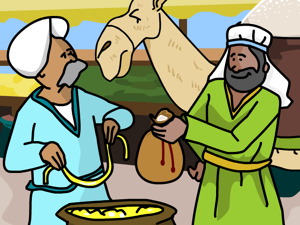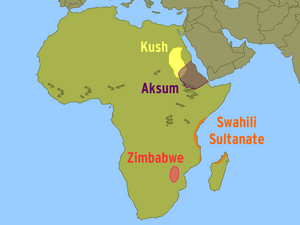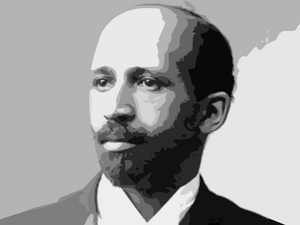Mansa Musa launched in BrainPOP Social Studies May 9, 2019.
Summary[]
After Tim got out of bed while Moby raises the golden touch on him. The apple transformed to gold (which Tim doesn't want the golden touch) until Tim explains about Mansa Musa (which his letter turned to gold).
While Tim is explaining, Moby turns his coins into gold. "Would you stop that?" Tim encourages him.
At the end, Moby is now transformed to gold, too. Tim faints.
Appearances[]
Transcript and Quiz[]
Quotes[]
- [last lines]
FYI[]
Famous Faces[]

Before travel influencers were even a thing, Ibn Battuta (1304–1369) made a career out of documenting his journeys to far-flung places. He first left his home of Tangier, Morocco at age 21. A Muslim, he headed out to make the hajj, or pilgrimage, to the holy city of Mecca, on the Arabian Peninsula. And then he just kept going. He’d end up staying on the road for 29 years, covering about 73,000 miles and most of the medieval Muslim world. His book about those travels, known as Rihla, or The Travels, became an important source for the Middle Ages’ mapmakers.
Battuta was born to a family of scholars. From the start, he was eager to see the world. He wrote in The Travels, “I set out alone, having neither fellow-traveler in whose companionship I might find cheer, nor caravan whose part I might join, but swayed by an overmastering impulse . . . to visit these illustrious sanctuaries.”
Battuta started his trip in 1325. After leaving Mecca, he traveled to Persia. Along the way, he saw cities that had been destroyed by the army of an invading Genghis Khan, leader of the Mongols. He went down the coast of East Africa, and declared its cities, “the finest and most beautifully built towns." He moved on to India and China, then back west to Europe, where he nervously tried to avoid the Black Death. And he passed by Cairo, Egypt, where Mansa Musa, the emperor of Mali, had stopped just a few years before. The stories he heard there about the emperor’s wealth must have made an impression: Battuta’s last long trip took him across the Sahara Desert and into Mali.
After returning home for good, Battuta wrote Rihla in 1354. He’d kept no notes and dictated from memory. He probably copied some information from books by earlier travelers, a practice that was common at the time. Venetian explorer Marco Polo had done the same thing in his 1300 account of visiting the court of Kublai Khan in China. But Battuta also visited areas that few others writers chronicled, like Mali, and historians have been able to verify many of his details.
The Jewish mapmakers of Spain, who were said to be the most skillful in Europe at the time, put his knowledge to work. Both Battuta and Polo are among the sources for their famous Catalan Atlas, which is now considered our best surviving medieval map.
Mother Nature[]

If there’s anything you know about the Sahara Desert, it’s that it’s hot — really hot — and dry. In fact, its 3.6 million square miles contain some of the hottest, driest places on Earth. Some parts of it haven’t seen rainfall in decades. But it wasn’t always this way. The walls of a mountain range in Tassili, Algeria offer a glimpse at a very different landscape: Some 7,000 years ago, humans carved images of gazelles, giraffes, and even hippos on the sandstone walls. For people to have known those animals, the land must have been much greener back then.
Climate scientists confirm it: The Sahara hasn’t always been a desert. It has swung back and forth between drier and wetter periods, each lasting thousands of years. When more water is locked up in the ice at Earth’s poles, there’s less rain in the Sahara; when these ice ages end, more rain returns. Even small changes in rainfall that happen year to year can affect the desert's size. Just a few more millimeters of rainfall in one year can cause the desert’s edges to retreat by miles.
Back when the artists of Tassili lived, the area was in a green phase that lasted a few thousand years. It was forests and savanna, or grassland, with lakes and rivers. Humans had previously been hunting and gathering for food, moving around to follow their prey. But with food now plentiful in the area, they started putting down roots. They kept livestock, grew grain, and produced striking art.
Eventually, the sands slowly began to take over again. The dryness pushed people out toward places that were still lush, like the Nile Valley. Squeezed together into towns, these populations grew dense enough to create the first kingdoms of the Nile. Meanwhile, the Sahara Desert became dangerous to cross. It developed into a barrier between sub-Saharan Africa and Eurasia. The two regions developed independently for thousands of years ... until camel caravans brought them together again.
In Depth[]

As long as merchants have lived on both sides of the Sahara Desert, they’ve traded across it. But since the trip had to be made on foot, it was too dangerous to happen regularly. Then around 300 C.E., a new technology emerged to change that: camel caravans.
Camels are perfectly suited for desert travel. They can go as long as 10 days without drinking water, and their wide, padded feet keep them from sinking into the sands. Their nostrils can close against sand, and their long eyelashes and tufts of ear hair provide good protection, too. Plus, drivers in the Nile Valley developed a saddle that let the beasts carry heavy loads across long distances. Caravans started hopscotching the desert, oasis to oasis. They would move through the night and rest during the hottest part of the day.
With the camels carrying goods and water, trips became quicker and more profitable. Goods like textiles, leather, and cola nuts began moving regularly across the sands. But the most valuable cargo was salt and gold. Central Africa needed salt: In a hot climate without a single ice cube in sight, salting was one of the only ways to preserve fresh food. Meanwhile, Europe and the Middle East were eager for the gold that was plentiful in Central Africa. This would be the backbone of trans-Saharan trade, which linked North Africa with the sub-Saharan empires. Traders also brought the new religion of Islam, which had swept across North Africa.
Profits from this trade would fund the start of the empires of Western Africa. Money began to collect in the towns in the Sahel, the savanna just below the Sahara where trade routes ended. But to keep the merchants coming, they needed to be able to guarantee security. As cities and royalty banded together to provide manpower, they became the first large empire of western Africa. The Empire of Ghana spent much of the first millennium growing as trade boomed. It was eventually succeeded by the Empire of Mali around 1230, and then the Empire of Songhai in the 15th century. Across these empires, gold—mined and sold by West Africans—provided hundreds of years of prosperity.
Way Back When[]

Mali was a great African empire, but it was not the only one. You’ve probably heard of ancient Egypt, too. The continent saw many other empires rise and fall, from the days of Cleopatra and even into the 1800s. Here are a few:
- The Kingdom of Kush (800 B.C.E.–350 C.E.) Located just south of Ancient Egypt, Kush was that empire’s frenemy: sometimes allied, sometimes an invader. It actually ruled Egypt for about a hundred years. Kushites developed iron smelting and an official writing system called Meroitic, which has never been deciphered. At the beginning of the Christian era, one Roman writer described Kush’s “fierce one-eyed queen,” who had managed to repel invading Romans. Along the way, she stole the head of a statue of Rome’s emperor, Augustus, and buried it under temple steps for Kushites to step on. It was discovered there by archaeologists in 1910.
- The Kingdom of Aksum (100–700 C.E.) Based in what’s now Ethiopia, Aksum was a naval and trading power. During Roman times, it controlled the mouth of the Red Sea, allowing it to become a popular hub for trade. But a bigger claim to fame came in the 4th century, when King Ezana converted to Christianity. As the story goes, he was convinced to convert by two young brothers he adopted after they’d shipwrecked on Aksum’s shores. More likely, the crafty king saw the benefit in aligning himself with other Christian lands. Regardless, Aksum was the first state to put the Christian symbol of a cross on its minted coins. Today, tourists still visit its 90-foot-tall stone pillars known as stelae. Shaped like mini-skyscrapers, they were actually gravestones for prominent people.
- The Swahili Sultanate (900–1500 C.E.) Sailors on the east coast of Africa had been trading with India since ancient Greek times. On sturdy wooden ships called dhows, they could make the trip in a month. Gold, steel, and ivory moved in one direction in the summer, and textiles and spices moved back in the winter. This trade gave birth to the Swahili Sultanate, a group of city-states that stretched for 1,000 miles along the coast. It’s named after Swahili, a mix of local Bantu languages and Arabic that developed there.
- The Kingdom of Zimbabwe (1200–1600 C.E.) In the 1800s, when European explorers stumbled onto the ruins of this kingdom’s capital, they were amazed. Circular walls reached up to 30 feet high and spanned four feet thick, and fit together without mortar. The Europeans thought they might have been built by aliens. But the actual builders had been the local Shona people, beginning in the 12th century. That was when Zimbabwe controlled the ivory and gold trade from interior Africa.
Real Life[]

Africa has the longest human history of any continent. After all, it’s where the first humans evolved. So it seems hard to believe that the first book covering the continent’s entire history came out only about a hundred years ago. William Edward Burghardt (W.E.B) Du Bois (1868–1963) wasn’t having that. Du Bois was a brilliant thinker and an academic superstar. He would become Harvard University’s first African-American Ph.D. and help create the field of sociology, the study of human society. At the turn of the century, he was interested in studying the connection between Africa and black people all over the world. But not only was there was no book on that topic—he couldn’t find a history of the continent of Africa at all.
American slavery, which had stolen people from Africa and brought them to the United States, had ended only a few decades before, with the Civil War. Many people still found it easy to believe that Africa was a place without history, much less great empires—a primitive world still stuck back in the Stone Ages.
But Du Bois had a nose for how prejudice could color facts. So, he set out to write his own book.
Du Bois wrote about the great African empires, like the Kingdom of Kush, which actually ruled Egypt for a period in the 8th century B.C.E; and the Swahili Sultanate, which was trading as far as China beginning in the 1st century C.E.
He also wrote about how history was made, and why that had been a problem for Africa. In his day, historians still focused their study on great men—kings and explorers—and great cities. They looked for written accounts and monuments, like ruins. But Africa’s history didn’t lend itself to that treatment. Many of its languages weren’t written down. Written records existed, but far fewer and more broken up than what historians were used to seeing in Europe and Asia.
Du Bois’ book, The Negro (1915), would go on to be the basis of America’s first college course in African history, held at Howard University in 1922. And it inspired scholars—including a wave of African ones—who would revolutionize the study of African history in the 1950s and '60s. Bringing in new disciplines—like linguists who could track the development of language, and geneticists who could trace human development in DNA—greatly deepened our vision of African history.
As for Du Bois? He went on to co-found the National Association for the Advancement of Colored People (NAACP), a ground-breaking civil rights organization that is still going strong today.
Trivia[]
- Tim mentions Darth Vader at the beginning of the movie.
- King Midas
Primary Source[]
There is none.
